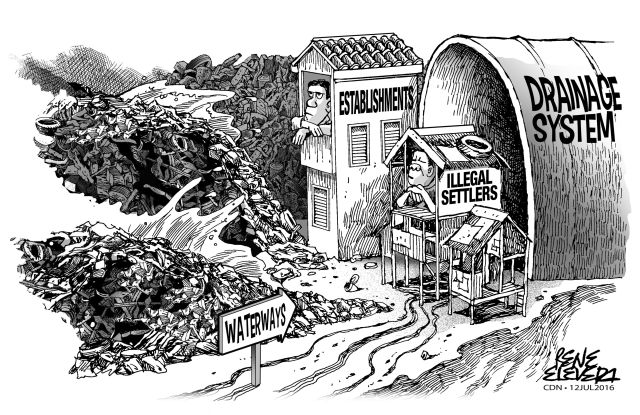The July 1 downpour erased any lingering doubts that the El Niño dry spell is gone for now in a big way as darkened skies gave way to rain that, while welcomed as cooling relief by Metro Cebu residents, eventually made life uncomfortable for them hours later.
Garbage that was left uncollected along the roads and canals later blocked drainage systems that could have reduced the floodwater down to manageable levels.
Jeepney and taxi terminals in Metro Cebu’s malls were filled with passengers that had to wait hours for a ride home while motorists also had to endure the traffic congestion that ensued due to the floodwater.
It’s been three days since typhoon “Butchoy” left the country but the state weather bureau Pagasa said the country will face more typhoons that are just and even more severe than the last one.
In the wake of the floods of which plenty of blame goes around, city residents look up to their new or reelected officials for answers. But thankfully, the news about Metro Cebu’s flooded streets caught the attention of presidential assistant to the Visayas Michael Dino enough for him to ask for assistance from Public Works and Highways Mark Villar, who met with stakeholders at Mega Cebu to promise action and plans for long-term solutions to the flooding and traffic problem.
The deployment of an amphibious excavator to dredge the Mahiga Creek may be more than a symbolic gesture of the Duterte administration’s commitment to Metro Cebu but anyone who’s been following the perennial problem of flooding for years knows the core factors that made it among the persistent in decades and it’s not just about garbage, even if it is a big part of it.
The core problem lies in the clogging of the waterways caused not just by the occupation of the settlers in easement zones of rivers and creeks but also big commercial establishments that set up shop in those areas long before the concept of sustainable urban planning was even considered.
Former mayor Michael Rama set up a task force that would require these commercial building owners to contribute more to ease the flooding but these owners are adamant against relocating due to the costs involved.
Their presence along with the settlers who chose to live in creeks and rivers due to the proximity to their workplaces resulted in garbage that all but clogged up any openings for floodwater to seep through and escape to the sea. Cebu City Mayor Tomas Osmeña proposed to set up water catchments that would reduce the water level but everyone knows that it cannot be built overnight.
So it’s not just settlers but commercial establishments located in these waterways that should set up mitigation measures other than culverts that would prevent floodwater from spreading out into outlying areas if relocating to other areas is out of the question.
Disclaimer: The comments uploaded on this site do not necessarily represent or reflect the views of management and owner of Cebudailynews. We reserve the right to exclude comments that we deem to be inconsistent with our editorial standards.

